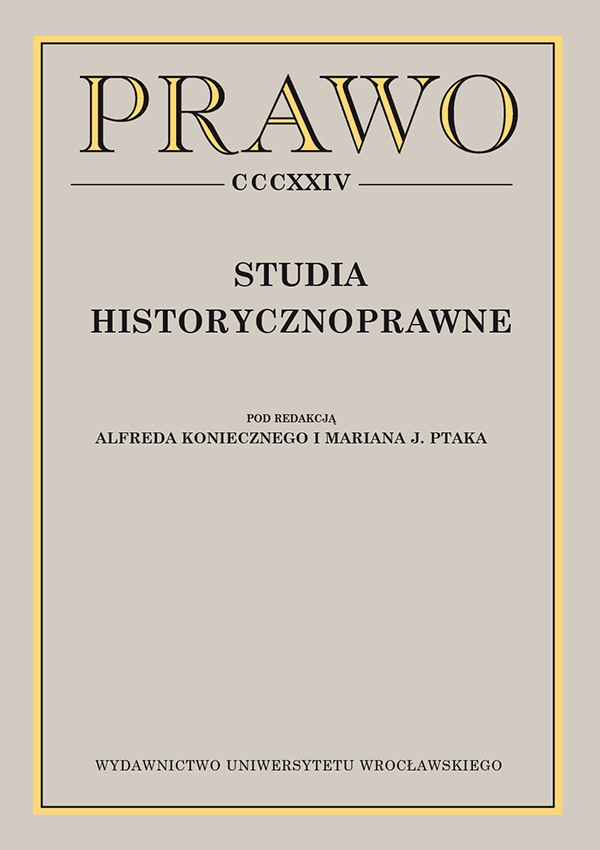

Artykuły

Mixed legal systems, especially those of Poland’s former partitioners, and the work on the codification of civil and commercial law in the Second Polish Republic
The author explores the question of codification of civil and commercial law in the Second Polish Republic in conditions of mixed legal systems, especially those of Poland’s former partitioners. The co-existence in independent Poland of several legal systems prompted the country’s codifiers to conduct extensive comparative studies, as a result of which in the codification process they drew also on other legislative systems from Europe and even other continents.
The author argues that the common denominator, developed by Poland’s Codification Commission, of the intermingled legislations encompassed primarily the legislations of the partitioning states, complemented by other legal systems, and what bound them together was the Polish, original legal thought. A model, not always enactable, consisted in creating a synthesis of the legislations of the former partitioners and more recent developments in law. In particular, the codifiers wanted to avoid radical solutions highlighting one system or model of law in order to avoid too great upheavals in the various provinces of the state.
A model example of putting the idea of “mixed systems” into practice is the Code of Obligations of 1933, which combined elements of the Romanesque and the German systems. Both these systems were also in evidence — in varying mutual relations and scope of use — in other acts of parliament and draft codifications of civil law.
In the Commercial Code, on the other hand, pragmatic considerations prevailed over the idea of a synthesis, hence the predominance of German and Austrian solutions. In the laws concerning industrial property, the provisions dealing with the fundamental question of obtaining patents were based on the Romanesque system, while the Act on Combatting Unfair Competition was closer to the French rather than the German system. The Polish bill of exchange law, taking into account convention-based solutions the bill of exchange rules of 1910 and 1912, was similar to the German regulations; similarly, the Polish cheque law was based on the provisions of the Hague Convention of 1912, the Austrian and the German cheque laws as well as the later cheque rules of 1931.
Die Grenzgebiete der Rechtssysteme, insbesondere der Nachteilungszeit, in den Kodifizierungsarbeiten betreffend das Zivil- und Handelsrecht der Zweiten Polnischen Republik
Der Verfasser behandelt die Probleme der Kodifizierung des Zivil- und Handelsrechts in der Zweiten Polnischen Republik vor dem Hintergrund der Berücksichtigung der Grenzgebiete von Rechtssystemen, insbesondere der Nachteilungszeit. Die Koexistenz von einigen Rechtssystemen im unabhängigen Polen veranlasste unsere Kodifikatoren, umfangreiche vergleichende Rechtsanalysen durchzuführen. Infolge dessen hat man bei der Kodifikation des Rechts zu anderen europäischen und sogar weltweiten Gesetzgebungsverfahren gegriffen.
Der Autor beweist, dass vor allem das Recht der Nachteilungszeit und ergänzend auch andere Rechtssysteme den gemeinsamen, durch die Kodifikationskommission der Republik Polen ausgearbeiteten Nenner für die sich durchdringenden Einflüsse verschiedener Rechtsvorschriften bildeten, und die polnische, originelle Rechtsidee diente als verbindendes Element. Ein gewisses Modell, das nicht immer realisierbar war, stellte eine Synthese des Rechts der Nachteilungszeit und der neuen Strömungen im Recht dar. Man wollte insbesondere radikale Lösungen vermeiden, die ein gewisses System bzw. ein Rechtsmodell einseitig bevorzugen, damit zu den zu weit gehenden Erschütterungen in den einzelnen Staatsteilen nicht kommt.
Die Idee des „Grenzlandes“ realisierte fast modellartig das Schuldrechtsbuch von 1933, das in sich die Elemente des romanischen und germanischen Systems vereinigte. Diese beiden Systeme, im diversen gegenseitigen Verhältnis und verschieden angewandt, waren auch in anderen Gesetzen und Kodifikationsentwürfen aus dem Bereich des Zivilrechts sichtbar.
Beim Handelsgesetzbuch wiederum waren pragmatische Gründe stärker als die Idee der Synthese, so dominierten hier die deutschen und österreichischen Lösungen. Die Vorschriften betreffend gewerbliche Schutzrechte, bezogen auf die fundamentale Frage zur Erlangung eines Patents, wurde auf dem romanischen System gestützt, das Gesetz über die Bekämpfung des unlauteren Wettbewerbs stand dagegen dem französischen System näher. Das polnische Wechselrecht, unter Berücksichtigung der konventionalen Lösungen Wechselreglement aus den Jahren 1910 und 1912 platzierte sich im Bereich der germanischen Rechtsvorschriften. Auch das Scheckrecht basierte auf den Bestimmungen der Hager Konferenz von 1912, auf dem österreichischen und deutschem Scheckgesetz und auch dem späteren einheitlichen Scheckreglement aus dem Jahre 1931.